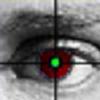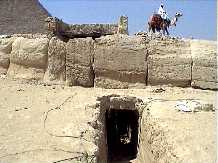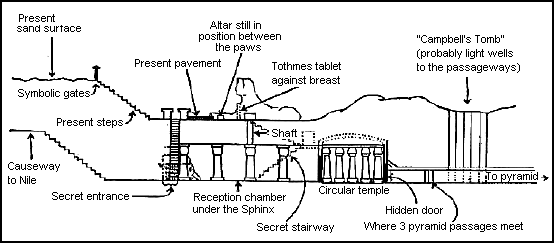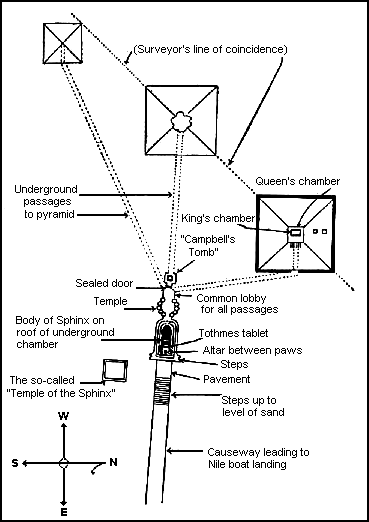 Osiris, the Egyptian god of the underworld
http://www.towers-on...es/shaftos1.htm
"Opening The Lost Tombs" - The Tomb Of Osiris (excerpts)
Osiris, the Egyptian god of the underworld
http://www.towers-on...es/shaftos1.htm
"Opening The Lost Tombs" - The Tomb Of Osiris (excerpts)
On the 2nd of March 1999, the FOX Television Network broadcast a programme entitled 'Opening The Lost Tombs: Live From Egypt.' The closing section of the programme dealt with the 'Tomb of Osiris', the location described in these pages. Here was an opportunity for the man in charge of the excavations to end the speculation about what lies beneath Khafre's causeway.
The Main Points...
The following is a summary of the main points raised by this section of the programme. Attributions are given to indicate if a point arises from statements made by the FOX presenters (FOX) or from Doctor Hawass himself (ZH). Statements in italics are explanatory notes added by The Towers On-Line.
o Doctor Hawass has discovered a subterranean chamber that lies at the bottom of a long shaft not far from the Sphinx. (FOX)
o Doctor Hawass discovered the chamber about a year ago and refers to it as his greatest adventure ever. (FOX)
o The chamber is the one talked about by Herodotus. (ZH) ("...underground sepulchral chambers on the hill where the pyramids stand; a cut was made from the Nile, so that the water from it turned the site of these into an island." - The Histories Book 2, s 124)
o Doctor Hawass has established that the chamber is the 'Tomb of Osiris'. (ZH)
o The second level chamber was obscured with dirt and sand. Doctor Hawass and his men cleared it to find a burial chamber with six rooms cut in the rock. (FOX)
o Doctor Hawass found two red granite sarcophagi, pottery and bones. (ZH)
o Doctor Hawass dates the pottery to 500 B.C., 2,500 years ago. (ZH)
o Doctor Hawass found the shaft leading to the third level. (My interpretation, based on Suzy Kolber (FOX): "And what made you think that there was anything beyond this?" ZH: "You have to look for the other level. This is the adventure.")
o When Doctor Hawass found the third level, it was submerged. (FOX)
o To lower the sarcophagus into the chamber, the shaft was filled with sand and the sarcophagus was placed on top. The sand was removed via side-shafts cut for the purpose. As the level of the sand dropped, the sarcophagus was lowered down the shaft. (ZH)
o Archaeologists agree that a network of tunnels lies below the Giza plateau. (FOX)
o Doctor Hawass believes that Edgar Cayce's references to a lost civilisation are a legend, a myth. (ZH)
o Doctor Hawass stood in the entrance to what he said was an unexcavated tunnel. (ZH) (The entrance is located in the northwest corner of the chamber.)
Matters Arising...
This section highlights some discrepancies between the discovery of this location as reported in the television programme and other historical reports. It also suggests why Herodotus was told that this location - if indeed it is the same one - was Khufu's burial chamber, and for comparative purposes gives examples of other locations also called the 'Tomb of Osiris'.
From points 1 and 2 above, Doctor Hawass discovered the subterranean chamber recently, however it is clear from the Excavations At Giza excerpt reproduced on page 1 and the London Daily Telegraph article of the 4th March 1935 reproduced on page 3 that the location was known about many years ago.
From points 5, 6 and 8 above, on clearing the second level chamber Doctor Hawass found six sidechambers cut into the rock and the shaft descending to the third level chamber. Two of the sidechambers contained red granite sarcophagi, Again, it is clear from the reports cited above that Doctor Selim Hassan was fully aware of the layout of the second chamber with its sidechambers and also of the shaft to the third level, although he believed the two monolithic sarcophagi to be of basalt rather than granite.
From points 3 and 4, we are told that this is the chamber talked about by Herodotus, and furthermore that it is the 'Tomb of Osiris'. Herodotus is thought to have visited Egypt in the middle of the fifth century B.C., this being approximately seventy five years after the end of the 26th (Saite) dynasty. This dynasty started with Necho, king of Sais around 666 B.C. and ended with the demise of Psamtik III around 525 B.C. It was during this time that there was a resurgence of interest in the Old Kingdom. The old kings were worshipped once again and stories retold about their deeds. A stela found in the Temple of Isis and dated to the 26th Dynasty tells how Khufu made repairs to this temple (constructed in the eastern cemetry at Gizeh in the 21st Dynasty) and repaired the headdress of the Sphinx (see Lehner, The Complete Pyramids, p39) so it is clear that at least some of the stories being told at the time were somewhat economical with the truth.
From point 7, Doctor Hawass dates the pottery found in the second level chamber to around 500 B.C., i.e. close to the end of the Saite period. On the assumption that the chambers were constructed in this period, they could only have been about two hundred years old at most at the time of Herodotus's visit. This might explain why Herodotus was told that the 'underground sepulchral chambers' were associated with Khufu, the story being a remnant of the resurgence of interest in the Old Kingdom.
It was not made clear whether Doctor Hawass was dating the entire complex to this period or referring specifically to the second level. On other occasions when talking about this 'Tomb of Osiris', he has dated it to the time of the 18th Dynasty. These questions about the dating of the location and how the date was arrived at will no doubt be answered when Doctor Hawass publishes his report on the location. This report might also describe the diligent research from which he established that this is indeed the location talked about by Herodotus.
Doctor Hawass did not elaborate on why he thinks that the location is a symbolic 'Tomb of Osiris'. It might be because it has some similarities in layout with the 'Tomb of Osiris' at Abydos. For those unfamiliar with this location, a fine account of its discovery and excavation can be found in an Illustrated London News article entitled "Strabo's Well" and Tomb of Osiris taken from the 30th May, 1914 edition.
Another 'Tomb of Osiris' is mentioned by Labib Habichi in his essay "Sais And Its Monuments", (see Annales Du Service Des Antiquites De L'Egypte vol. 42, p371):
o
Herodotus, who visited it (Sais) in the middle of the fifth century B.C., not long after the fall of this (26th) dynasty, gives us a detailed description of its buildings...Concerning the tombs of its kings, he says that the sepulchre of Apries lies within the temenos wall of Neith. "This wall encloses the tomb of Amasis as well as that of Apries and his family." (Histories, Book 2, s 169) "It encloses also the tomb of Osiris which stands behind the temple, large stone obelisks and a lake built with stones on which the Egyptians represent the sufferings of Osiris." (Histories Book 2, s 170-171)



































































